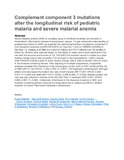Complement component 3 mutations alter the longitudinal risk of pediatric malaria and severe malarial anemia
Date
2021-11-19Author
Raballah, Evans
Anyona, Samuel B
Cheng, Qiuying
Munde, Elly O
Hurwitz, Ivy-Foo
Onyango, Clinton
Ndege, Caroline
Hengartner, Nicolas W
Pacheco, Maria Andreína
Escalante, Ananias A
Lambert, Christophe G
Ouma, Collins
Obama, Henri C Jr T
Schneider, Kristan A
Seidenberg, Philip D
McMahon, Benjamin H
Perkins, Douglas J
Metadata
Show full item recordAbstract
Severe malarial anemia (SMA) is a leading cause of childhood morbidity and mortality in holoendemic Plasmodium falciparum transmission regions. To gain enhanced understanding of predisposing factors for SMA, we explored the relationship between complement component 3 (C3) missense mutations [rs2230199 (2307C>G, Arg>Gly102) and rs11569534 (34420G>A, Gly>Asp1224)], malaria, and SMA in a cohort of children (n = 1617 children) over 36 months of follow-up. Variants were selected based on their ability to impart amino acid substitutions that can alter the structure and function of C3. The 2307C>G mutation results in a basic to a polar residue change (Arg to Gly) at position 102 (β-chain) in the macroglobulin-1 (MG1) domain, while 34420G>A elicits a polar to acidic residue change (Gly to Asp) at position 1224 (α-chain) in the thioester-containing domain. After adjusting for multiple comparisons, longitudinal analyses revealed that inheritance of the homozygous mutant (GG) at 2307 enhanced the risk of SMA (RR = 2.142, 95%CI: 1.229–3.735, P = 0.007). The haplotype containing both wild-type alleles (CG) decreased the incident risk ratio of both malaria (RR = 0.897, 95%CI: 0.828–0.972, P = 0.008) and SMA (RR = 0.617, 95%CI: 0.448–0.848, P = 0.003). Malaria incident risk ratio was also reduced in carriers of the GG (Gly102Gly1224) haplotype (RR = 0.941, 95%CI: 0.888–0.997, P = 0.040). Collectively, inheritance of the missense mutations in MG1 and thioester-containing domain influence the longitudinal risk of malaria and SMA in children exposed to intense Plasmodium falciparum transmission.
URI
https://doi.org/10.1177/15353702211056272https://journals.sagepub.com/doi/abs/10.1177/15353702211056272
http://ir-library.mmust.ac.ke:8080/xmlui/handle/123456789/2412
Collections
- Gold Collection [1026]

